Influence of air pressure and temperature on refraction
Warning: Firefox renders the formulas
correctly (Chrome and Microsoft
Edge can't properly render the formula [MathM] correctly)!!!
The influence of air pressure and temperature for different
topocentric altitudes is determined by using ray tracing
integration along the apparent altitude (Hohenkerk&Sinclair,
1985). The reference used is StdAtm, being MUSA76 at lapse
rate=0.0065K/m, temperature ground level 15C, RH=0% and air
pressure ground level 1013.25mbar.
Influence of Air Pressure (P) on refraction is expressed as:
The P at ground level is varied between 871.4mbar and 1074mbar.
Influence of Temperature (P) on refraction is expressed as:
The T at ground level is varied between -40C and 40C.
In below evaluation the topocentric instead of apparent altitude
is used as variable, this because in levelling and terrestrial
refraction the topocentric altitude is quite determined due to
geometry. For astronomical refraction the topocentric altitudes
was determined by subtracting the refraction (result) from the
apparent altitude (input).
The three types of refraction are checked by varying one parameter
(P or T) while keeping the other (T or P) at the StdAtm value:
- Astronomical refraction
The refraction is determined for a light path from the eyes'
position to the end of the Earth's atmosphere (in direction of a
celestial object).
- Levelling
refraction
The refraction is determined for a light path that has a
large part level with the Earth's geoid, aka towards/from a vast
level surface below the eyes' position. Also known as dip.
- Terrestrial refraction
The refraction is determined for a light path that goes from
the eyes' position to a terrestrial object higher or lower than
the eyes' position.
Astronomical refraction
The Near Height (at the observer) is 10m.
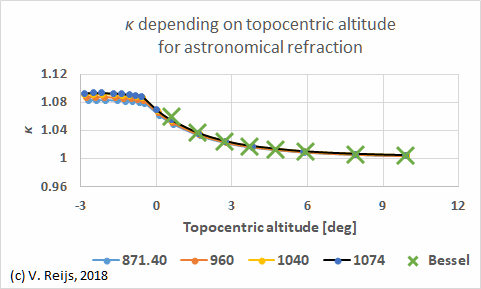
So there is air pressure dependency and larger topocentric altitude
dependency on the κ for astronomical refraction. Remember that for
altitudes below 0deg, levelling
refraction plays a part (but does not have to be down to the
ground level).
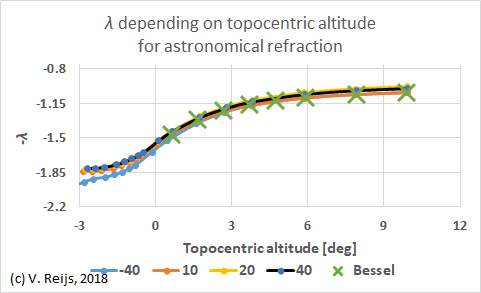
So there is temperature dependency and larger topocentric altitude
dependency on the λ for astronomical refraction. Remember that for
altitudes below 0deg, levelling
refraction plays a part (but does not have to be down to the
ground level).
Bessel's results (1830, page LIX-LXI and 539) at apparent altitude
of 0.5deg (10C, 1002mbar) compare well with the ray tracing results
(see the green crosses in above graphs).
For high altitudes (>10deg) the λ and κ are getting close
to 1. This maps on observations of others, such as Bennett (1982,
page 258).
The air pressure and temperature influence has also been extensively
evaluated by Tschudin (unpublished yet).
Levelling refraction
The Near Height (at the observer) varied between 11 and 750m and
Distant Height is 10m. This changes the topocentric altitude.
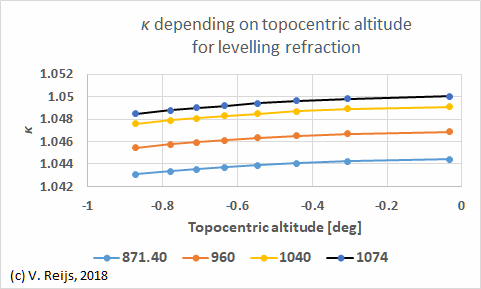
So there is slight air pressure and topocentric altitude dependency
on the κ for levelling refraction.
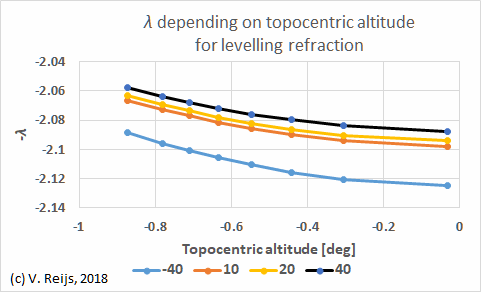
So there is temperature and topocentric altitude dependency on the λ
for levelling refraction.
Terrestrial refraction
The Near Height (at the observer) is at 10m and the Distant
Height varied between 11 and 1500m, while the Distance to Distant
Height varied from 85 to 8000m. These change the topocentric
altitude.
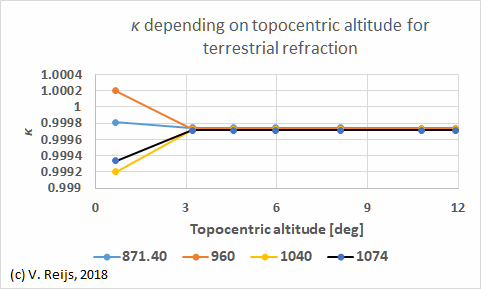
So there is almost no air pressure or topocentric altitude
dependency on the κ for terrestrial refraction, it is quite stable
at 1.000
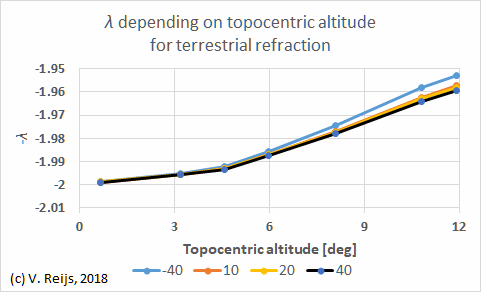
So there is almost no temperature dependency (between 0 and 40
degrees) on the λ for terrestrial refraction. But λ is depending on
the topocentric altitude.
The
resulting graphs will change if different Near and Distant Heights
are used (even resulting in same topocentric altitude), but this
evaluation gives at least some idea of the influences
For
terrestrial refraction the expected values for κ=1
and for λ=-2
(following the formula
of Thom [1958]), and the above ray tracing results map that.
General observations
In
general the influence on
the κ and λ
due to topocentric altitude and temperature (in order of
influence) are much lager than air pressure.
In case of levelling refraction
the influence of temperature is larger than topocentric altitude.
References
Bennett, G.G. 1982. 'The calculation of astronomical refraction in
marine navigation', Journal of Inst. navigation, Vol 35: pp. 255-59.
Bessel, F. W. 1830.'Tabulae regiomontanae reductionum observationum
astronomicarum ab anno 1750 usque ad annum 1850 computatæ', in
https://archive.org/stream/tabulaeregiomon00bessgoog#page/n614/mode/2up
[accessed January 1 2018].
Hohenkerk, Catherine Y., and A.T. Sinclair. 1985. "The computation
of angular atmospheric refraction at large zenith angles." ed. by HM
nautical almanac office. Cambridge.
Thom, Alexander. 1958. 'An empirical investigation of atmospheric
refraction', Empire Survey Review, Vol 14: pp. 248-62.
Tschudin, Marcel E. to be published. 'Refraction near the horizon—an
empirical approach. Part 2: Variability of astronomical refraction
at low positive altitude (LPAAR)'.
Acknowledgements
I would like to thank people, such as Marcel Tschudin
and others for their help and constructive feedback. Any remaining
errors in methodology or results are my responsibility of
course!!! If you want to provide constructive feedback, let me know.
Disclaimer and Copyright
 Home
Home Up
Up Search
Search Mail
Mail
Major content related changes: January 1, 2018





